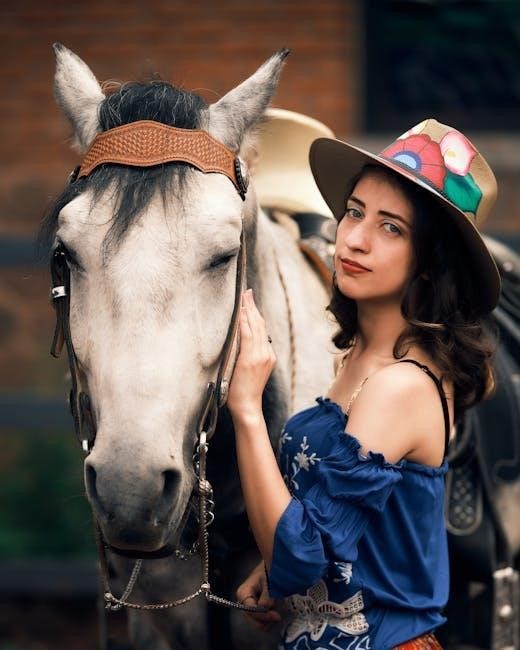A Western saddle is a type of saddle designed for horse riding, originating from the American West. It is known for its sturdy design, comfort, and functionality, often used for trail riding, ranch work, and competitions. Proper sizing is essential to ensure both rider comfort and horse well-being, making it a critical factor in selecting the right saddle. Understanding the basics of Western saddles and their sizing guide is the first step toward making an informed decision for optimal performance and harmony between horse and rider.
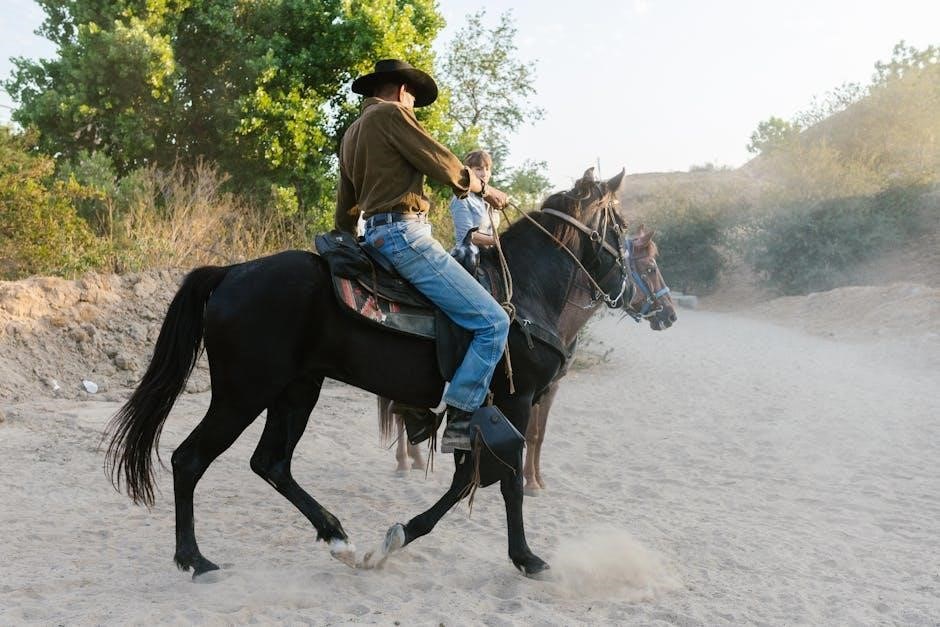
What is a Western Saddle?
A Western saddle is a specialized riding saddle designed for comfort and durability, primarily used in Western-style horse riding. It features a sturdy tree, a raised horn, and a pronounced cantle, providing support and security for the rider. The saddle is typically made from high-quality leather and is equipped with intricate tooling or decorative elements. Its design caters to activities like trail riding, cattle work, and competitive events such as reining or barrel racing. The Western saddle is known for its deep seat, which offers stability, and its wide, padded skirt, which distributes weight evenly, ensuring comfort for both the horse and rider.
Importance of Proper Saddle Size
Proper saddle size is crucial for both the horse’s comfort and the rider’s performance. A well-fitted saddle ensures even weight distribution, preventing pressure points that can lead to discomfort or injury for the horse. For the rider, the correct size provides optimal balance, control, and stability, enhancing riding efficiency and safety. Improper sizing can result in poor posture, difficulty controlling the horse, and long-term health issues for the horse, such as back strain or soreness. Selecting the right size involves considering the horse’s breed, size, and body type, as well as the rider’s height, weight, and riding style. Accuracy in sizing is essential for a harmonious riding experience.
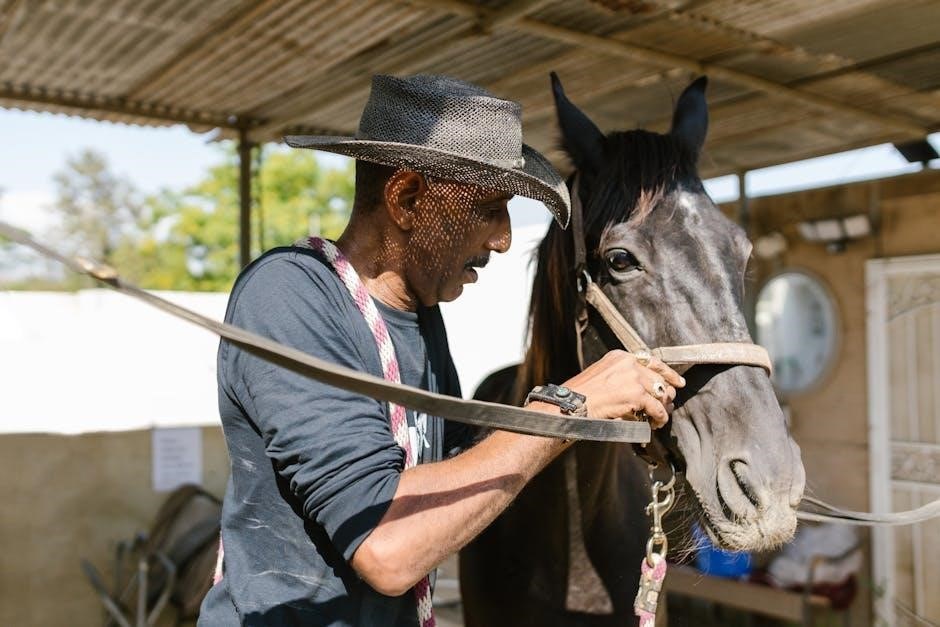
Types of Western Saddles
Western saddles vary in design and purpose, including trail, reining, barrel, and roping saddles. Each type caters to specific riding styles, ensuring optimal performance and comfort.
Trail Saddles
Trail saddles are designed for comfort and durability during long rides, often featuring a sturdy design with a moderate seat size and longer skirts for support. They typically have a simpler aesthetic compared to other Western saddles, prioritizing functionality over decoration. The tree is designed to distribute weight evenly, ensuring the horse’s comfort on extended trails. Seat sizes range to accommodate various rider preferences, while fender length allows for easy movement. These saddles are ideal for riders who spend hours exploring rugged terrain, offering both stability and flexibility. Proper sizing is crucial to ensure both rider comfort and horse well-being during long-distance adventures.
Reining Saddles
Reining saddles are lightweight and designed for precision and control, commonly used in reining competitions. They feature a minimalist design with a snug seat and minimal skirt length, allowing close contact between the rider and the horse. The tree is typically semi-quarter horse bars, ensuring a proper fit for the horse’s back. Seat sizes are tailored for individual riders, while fender length is shorter to enable freedom of movement. The horn is smaller but functional, aiding in dexterity during intricate maneuvers. Proper sizing ensures optimal balance, control, and comfort for both the rider and the horse, making reining saddles a favorite among competitive riders seeking precision and performance.
Barrel Saddles
Barrel saddles are specifically designed for barrel racing, emphasizing speed, agility, and precision. They are lightweight with a close-contact design, allowing riders to communicate effectively with their horses. The tree is typically a semi-quarter horse or full-quarter horse bar, ensuring a secure fit for the horse’s back. Seat sizes range to accommodate riders of various builds, while fender length is shorter for freedom of movement. The horn is smaller but sturdy, aiding in quick maneuvers during tight turns. Proper sizing ensures the saddle stays balanced, preventing interference with the horse’s motion. This design maximizes performance, making barrel saddles a preferred choice for competitive racers seeking both speed and control.
Roping Saddles
Roping saddles are built for durability and functionality, designed for events like calf roping; They feature a sturdy tree and a prominent horn for rope work. The seat is typically more padded for rider comfort during intense maneuvers. Fender length is longer to accommodate the rider’s leg position while roping. Proper sizing ensures the saddle sits securely on the horse’s back, with the tree matching the horse’s ribcage shape. Seat size should fit the rider snugly, allowing freedom of movement. The skirt design is streamlined to avoid interference during quick dismounts. Correct sizing ensures both horse and rider can perform effectively, making roping saddles a reliable choice for demanding tasks.
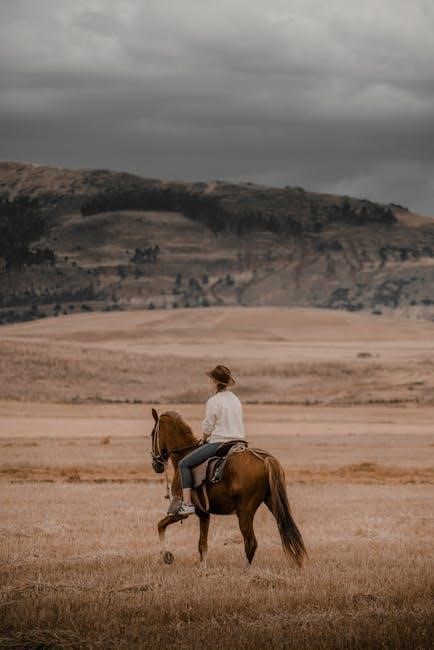
Key Components of a Western Saddle
A Western saddle’s key components include the tree (provides structural support), seat (ensures rider comfort), skirt (protects the horse’s flanks), horn (used for roping), and fenders (support the rider’s legs).
The Tree
The tree is the internal framework of a Western saddle, providing structural support and ensuring proper fit for both horse and rider. Typically made of fiberglass, wood, or plastic, it dictates the saddle’s shape and size. The tree must match the horse’s back contours to prevent discomfort or injury. A well-fitted tree distributes weight evenly, while an ill-fitting one can cause pressure points. The tree’s size and type are critical for optimal saddle performance and comfort, making it a cornerstone of the Western saddle size guide. Correct tree selection ensures harmony between horse and rider, enhancing overall riding experience and horse well-being.
Seat Size
Seat size in a Western saddle refers to the length of the seating area, measured from the base of the horn to the back of the cantle. Proper seat size is crucial for rider comfort and control. To determine the correct size, riders should consider their hip-to-knee measurement while sitting. Western saddles typically range from 12 to 17 inches in seat size, with smaller sizes for children and larger sizes for taller or heavier riders. A well-fitting seat ensures optimal balance and mobility, preventing discomfort during long rides. Choosing the right seat size enhances riding performance and overall satisfaction, making it a vital aspect of the Western saddle size guide.
The Skirt
The skirt is the part of the Western saddle that covers the tree, protecting the horse from the tree’s points. It is typically made of leather or synthetic materials and is designed to fit snugly around the horse’s back. The skirt’s length and shape vary depending on the saddle’s intended use. For example, trail saddles often have longer skirts for added protection, while barrel saddles have shorter skirts for greater freedom of movement. Proper skirt fit is essential to ensure the horse’s comfort and prevent chafing or pressure points. The skirt’s design also contributes to the saddle’s overall aesthetic appeal and functionality. Always choose a skirt style that suits your riding discipline and horse breed for optimal performance and comfort.
The Horn
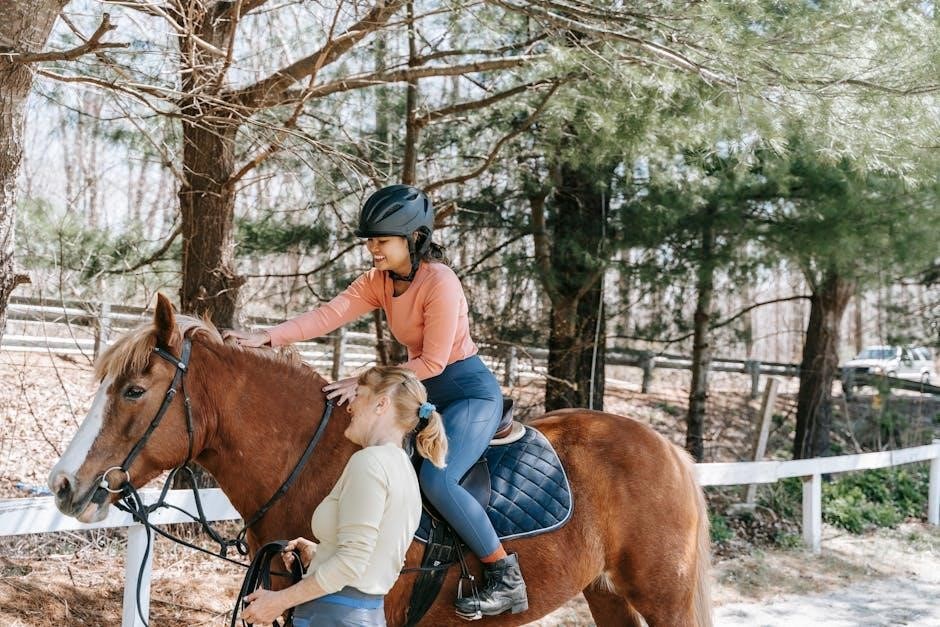
The horn is a distinctive feature of Western saddles, serving both functional and decorative purposes. It is a raised portion at the front of the saddle, typically made of leather or synthetic materials. The horn is used for dallying ropes during activities like roping or steer wrestling. Its size and shape vary depending on the saddle’s intended use, with roping saddles having larger, more prominent horns for better rope control. The horn’s placement and angle also impact the rider’s ability to handle ropes effectively. Proper horn size and positioning ensure optimal performance and comfort for the rider during specific disciplines. The horn is a critical component for functionality in Western disciplines.
The Fenders
The fenders are leather components attached to the saddle, extending from the skirt to the stirrup. They play a crucial role in protecting the rider’s legs from friction and wear caused by movement. Fenders are designed to allow smooth leg movement while maintaining control. Their length varies depending on the saddle type and intended use, with shorter fenders suited for precise control in disciplines like reining and longer fenders offering more protection in rugged trail riding. Proper fender length ensures comfort and prevents chafing, while incorrect sizing can lead to discomfort or restricted movement. Fenders are tailored to fit both the rider’s leg and the horse’s anatomy for optimal performance.
Fitting the Saddle to the Horse
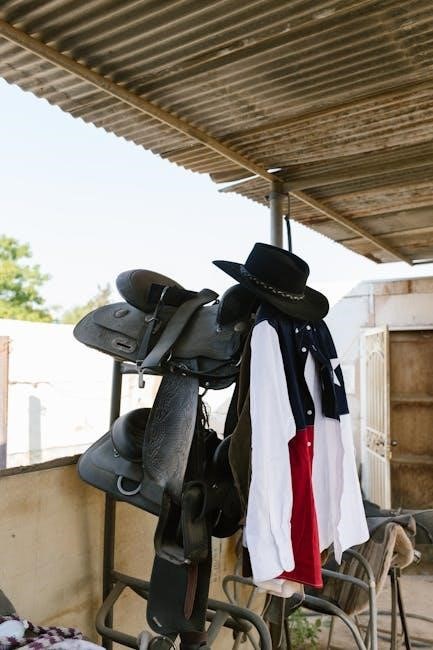
A well-fitted saddle ensures the horse’s comfort and prevents injury. Proper placement allows for even weight distribution, free movement, and clear breathing. The saddle should align with the horse’s back shape and muscle structure, avoiding pressure points. Regular adjustments are essential as horses develop and change shape over time. A correctly fitted saddle promotes optimal performance and strengthens the bond between horse and rider. Always consider the horse’s size, breed, and specific needs when selecting and fitting a saddle. Proper fit is crucial for both the horse’s welfare and the rider’s safety.
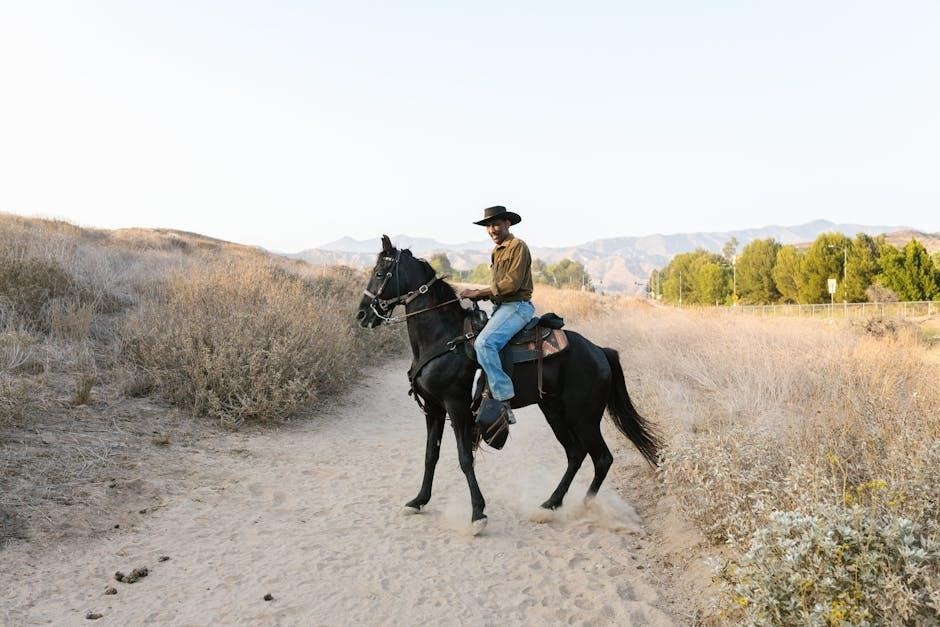
Measuring the Horse’s Back
Measuring the horse’s back is crucial for proper saddle fit. Start by locating the withers (highest point of the horse’s shoulder) and the last rib, which is typically 4-6 inches behind the withers. Use a flexible measuring tape or string to measure the distance between these two points. This measurement helps determine the appropriate saddle tree size. Ensure the horse is standing square and relaxed during measurement. The length obtained should match the saddle tree’s specifications. Accurate measurement ensures the saddle sits correctly, avoiding pressure points and discomfort for the horse. This process is essential for selecting a saddle that fits both the horse’s back shape and size.
Understanding Saddle Tree Sizes
Western saddles are built on a tree, which provides the structural framework. Saddle tree sizes refer to the width and shape of the tree, ensuring proper fit for the horse’s back. Common tree sizes include semi-quarter, full-quarter, and extra-full-quarter. Semi-quarter trees are narrower, suitable for smaller breeds or horses with refined back shapes. Full-quarter trees are the most common, fitting average-sized horses. Extra-full-quarter trees are wider, ideal for larger breeds or horses with broad backs. The tree size must align with the horse’s withers and ribcage to prevent discomfort or galling. Correct tree size ensures even weight distribution and optimal saddle performance for both horse and rider.
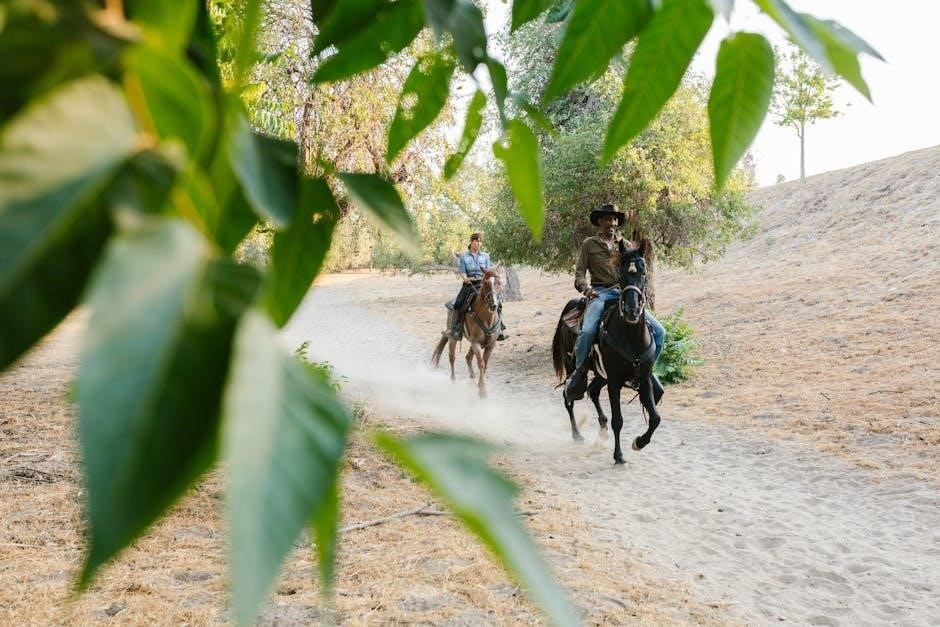
Fitting the Saddle to the Rider
Proper saddle fit ensures rider comfort and control. Seat size should match the rider’s body, with enough support for balance. Weight distribution and stirrup placement also matter for optimal performance.
Seat Size and Rider Comfort
Seat size is crucial for rider comfort and control. A properly fitting seat ensures the rider can sit comfortably with a slight gap behind the thigh. Measure seat size by sitting in the saddle with feet in stirrups. The seat should allow freedom of movement without feeling cramped or overly spacious. A seat too small can cause discomfort, while one too large may reduce control. Riders with longer legs may prefer a larger seat for better support. Seat cushioning and shape also impact comfort, with some saddles offering more padding for extended rides. Proper seat size ensures optimal balance and riding performance.
Rider Height and Weight Considerations
Rider height and weight play a significant role in selecting the right saddle size. A taller rider may require a longer stirrup length to maintain proper leg position, while a shorter rider needs shorter stirrups to avoid overreaching. Weight also influences saddle fit, as heavier riders may need a sturdier saddle with additional support. The saddle’s seat size and fender length should accommodate the rider’s leg length and body proportions. A balanced fit ensures comfort and control, preventing strain or discomfort during riding. Proper sizing for height and weight ensures optimal performance and longevity of the saddle. Always consider these factors for a tailored fit.
Additional Features Affecting Size
Additional features like skirt length, fender length, and tree points can impact saddle size. These elements must align with the rider’s needs and horse’s anatomy for optimal fit and performance.
Skirt Length
Skirt length plays a significant role in western saddle size and functionality. It refers to the part of the saddle that extends beyond the tree, covering the horse’s back. Proper skirt length ensures even weight distribution and prevents pressure points. A skirt that’s too short may cause discomfort, while one that’s too long can restrict movement. Skirt length should complement the horse’s back shape and size. For larger horses, longer skirts provide better coverage, while shorter skirts suit smaller breeds. Riders should also consider their leg length and riding style, as excessive skirt length can interfere with leg position. Balancing skirt length with overall saddle design ensures optimal fit and performance for both horse and rider.
Fender Length
Fender length is a critical factor in western saddle size, influencing both rider comfort and functionality. Fenders are the leather pieces attaching the stirrup to the saddle, allowing smooth leg movement. Proper fender length ensures the stirrup hangs correctly, preventing interference with the rider’s leg. Shorter fenders suit riders with shorter legs or those needing closer contact, while longer fenders accommodate taller riders or specific disciplines like roping. Incorrect fender length can cause discomfort or restricted movement. Riders should test fender length by sitting in the saddle and ensuring their legs move freely without the fenders digging into their thighs. This balance ensures optimal performance and comfort during rides.
Choosing the Right Size
Proper saddle fit is crucial for both horse and rider comfort. Measure the horse’s back and understand tree sizes to ensure a perfect match. This ensures optimal support and allows the rider to maintain a balanced position, which is essential for effective communication with the horse.
Considerations for Horse Breed
When selecting a western saddle, the horse’s breed plays a significant role in determining the proper size. Different breeds have unique back structures, muscle development, and wither shapes. For example, broader breeds like Quarter Horses may require a wider tree, while narrower breeds such as Thoroughbreds may need a flatter tree. The wither area, back length, and muscle tone vary among breeds, impacting saddle fit. A well-fitted saddle ensures comfort and prevents pressure points. It’s essential to consider these factors to maintain the horse’s mobility and overall well-being. Consulting a professional can help match the saddle to the horse’s specific needs.
Final Check and Adjustments
A final check ensures the saddle fits both the horse and rider perfectly. Verify the saddle is centered, with the gullet clearing the withers by 2-3 inches. The cinch should be snug but not overly tight, allowing for proper weight distribution. Adjust the fenders to align with the rider’s leg position for optimal comfort. Inspect the skirt to ensure it lies flat and doesn’t bunch up. Test the saddle during movement to confirm it stays in place without shifting. A visual inspection and a short test ride are essential to confirm the fit. These final adjustments ensure comfort, performance, and long-term satisfaction for both horse and rider.
A properly fitted Western saddle ensures optimal comfort and performance for both the horse and rider, making it essential to carefully follow sizing guidelines for the best experience.
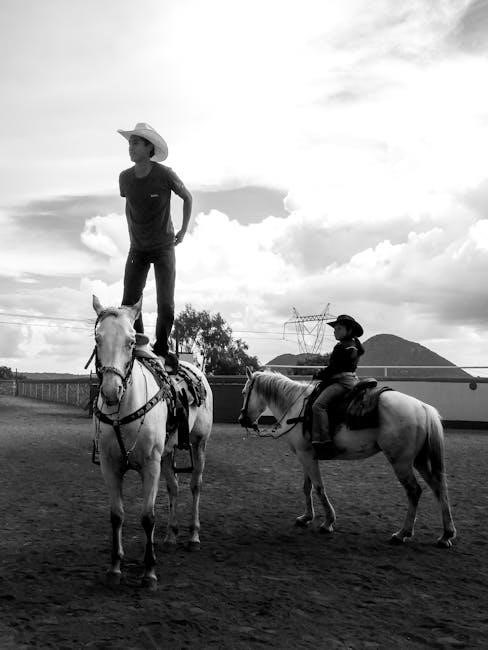
Proper saddle fit is crucial for both horse and rider comfort, ensuring optimal performance and preventing discomfort or injury. Understanding the horse’s back measurements and rider size is essential for selecting the right saddle. The saddle tree, seat size, and skirt length must align with the horse’s anatomy and rider needs. Considering the horse’s breed, weight, and intended use helps in choosing the appropriate saddle type. Final adjustments and regular checks ensure long-term comfort and effectiveness, making the saddle a vital investment for any Western rider.
Final Tips for Optimal Fit
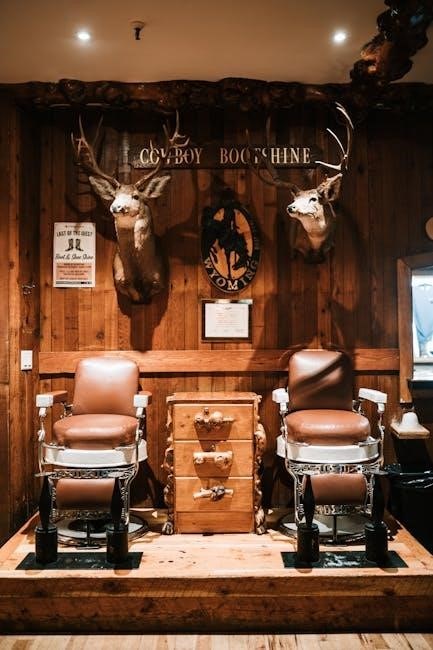
To achieve the best fit for your Western saddle, ensure the saddle is balanced and evenly distributed on the horse’s back. Always use a high-quality saddle pad to protect the horse and improve comfort. Regularly check the fit as horses’ physiques can change over time. Adjustments may be needed after significant weight changes or muscle development. Consider professional guidance for complex fittings. Ensure the rider’s position is comfortable, with feet resting naturally in the stirrups. Proper fit enhances performance, prevents discomfort, and strengthens the bond between horse and rider. Regular maintenance and adjustments are key to long-term satisfaction and optimal functionality.
